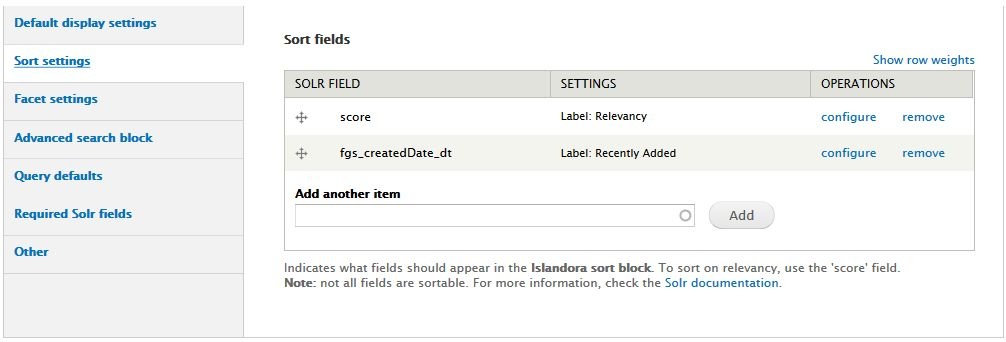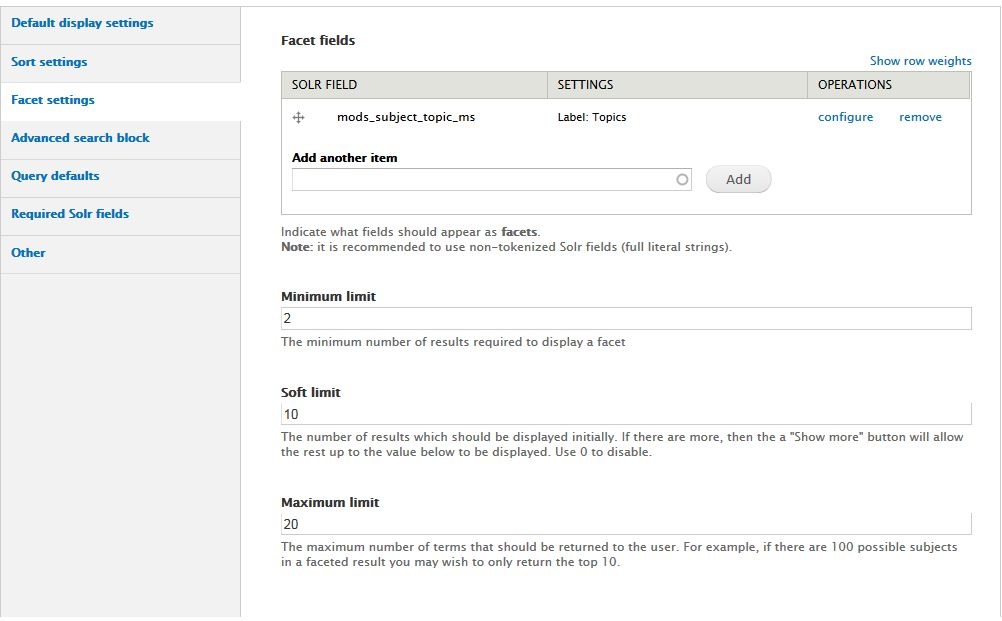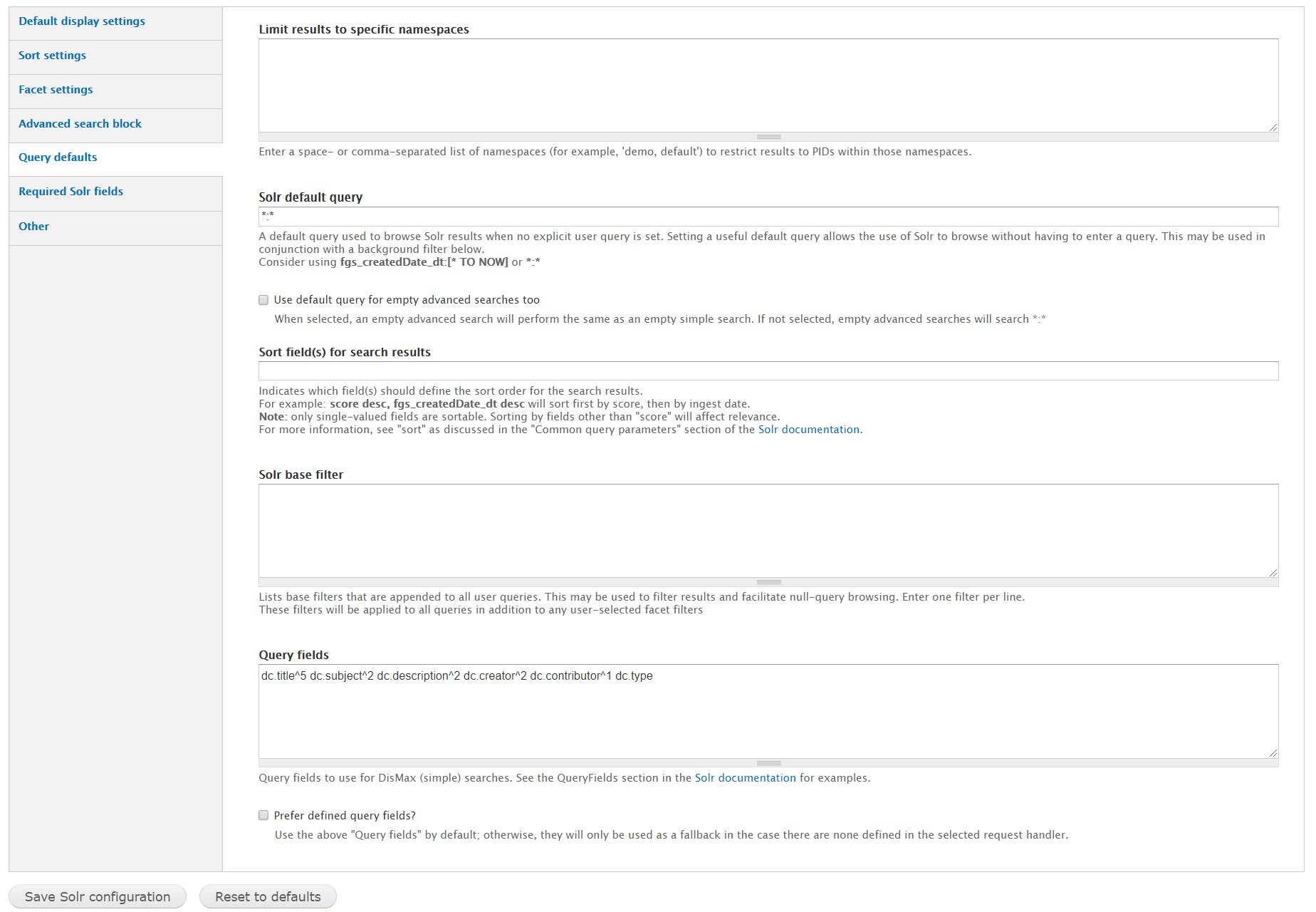The Solr Settings page has configuration options for searching and displaying Islandora object properties, descriptive metadata, full text, and OCR data stored in Solr.
This menu controls how search results are displayed.
The primary display profile determines the basic layout of search results on screen. Islandora Solr defines four profiles, but other modules can provide additional profiles.
If you enable multiple display profiles, to grant your users the choice of switching between them, you will also have to add the Islandora Displays block to a region (such as a sidebar, or above the content) in admin/structure/block.
Secondary display profiles present search results in formats that are more suitable for machine actionability.
These options will place an icon for the respective option next to your Solr search results.
This section provides options for setting which Solr fields display and how they are to be displayed in search results for the "List" and "Table" display profiles. The "Grid" and "Bookmark" profiles are not affected by these settings.
[To configure which fields display in result sets from "/islandora/repository/" requests, edit the template file islandora-basic-collection.tpl.php in the site's theme.]
Specify which metadata fields from Solr's index to display for each item in search results.
Configure Display fields
Check this box to limit the fields displayed to only those specified in Display fields. This setting will affect the "List" and "Table" display only. The "Grid" display is fixed. To configure the metadata for the "Bookmark" display see Islandora Bookmark.
Enter a number for how many objects should appear on each page of search results.
Caveat: The following are recently added settings not yet described in this document:
Check this box to enable a block that gives users a previous/next browse through search results after selecting an item, as well as an option to return to the main list of search results.
You can expose this function to users by adding the Islandora search navigation block to a region in admin/structure/block.
This menu lets you select fields that users can manipulate themselves to re-order the items on a search results page. These fields can be metadata fields or item properties ("fgs_" type fields) and those fields don't even have to be displayed fields. Or you can just specify relevancy.
The fields must not be multivalued fields in Solr. For more on this see Appendix D.
The default sort field is "score" which is a relevancy ranking based on how well the search query matches each result. The way that different fields are valued is configurable in Solr.
You can expose the sort fields to users by adding the Islandora sort block to a region (such as a sidebar) in admin/structure/block.

This is where you can specify terms that users can choose to help narrow down a result set to only those items that match that term, such as a specific subject heading, or were created by a specific author, or are of a certain type, or are within a certain date range.
Facet fields must be non-tokenized strings in Solr. For more on this see Appendix D. As you type in the fields in "Add another item" the eligible Solr fields will be indicated with the word "(string)."
You can expose the facet to users by adding the Islandora facets block to a region (such as a sidebar) in admin/structure/block.

You can now choose between having the facets display in the order of most frequent to least frequent and having them display alphabetically. This works for date facets as well.
Replace PID with Object Label - if the values in this Solr field are identifiers for objects in Islandora in the form of PIDs (e.g. islandora:collection_x) or URIs (e.g. info:fedora/islandora:collection_x), enabling this option will show those objects' labels (e.g. Collection X) instead.
This is where you can build search queries that target specific Solr fields. The "Islandora simple search" block, by contrast, searches across a broad set of fields which you can configure here under Query defaults > Query fields.
Advanced search fields should be tokenized fields in Solr. All Dublin Core fields, for example, are tokenized. For more on this see Appendix D.
Default boolean operator
"User-configurable" means to let the user choose the boolean operator between the search terms.
Set "AND" or "OR" as the default boolean operator.
For example:
You expose the Advanced search to users by adding the Islandora advanced search block to a region in admin/structure/block.
TIP: To present the Advanced search block on its own page, add the block to the "Content" theme region (the main section on a page). Then create a new Drupal node and set the Advanced search block to display on only that node.
Caveat: The following are recently added settings not yet described in this document:
This menu contains settings that apply to all Solr queries in Islandora.
Limit results to specific namespaces - Installations of Islandora that have namespace restrictions must enter the namespaces here to restrict the search results to only the relevant namespaces. You can enter more than one namespace.
Sort field for default query - Example: To set the Solr field for the MODS title element as the sort field with the ascending order specified, add this: mods_titleInfo_title_s asc
Solr base filter - Example: To prevent collection-level objects from appearing in Solr search result sets, you could add this: -RELS_EXT_hasModel_uri_s:"info\:fedora\/islandora\:collectionCModel"
Query fields - Example: To get Solr to search the OCR datastream, you could append this to the default list: OCR_t

This menu specifies which fields Solr uses to create the default repository browse result set and should probably not be changed.
If checked the "Debug mode?" will display the raw text of Solr queries in Islandora's Drupal interface. It should be unchecked on a production site.
Note:
Many of the options configured in the Solr Settings menus affect only searches and results sets associated with Solr searches. You can recognize a Solr search by the URL string "/islandora/search/...". Other types of searches, such as browsing using URLs like "/islandora/repository/" and some like "/islandora/object/..." are not affected by all options set here in Solr Settings.